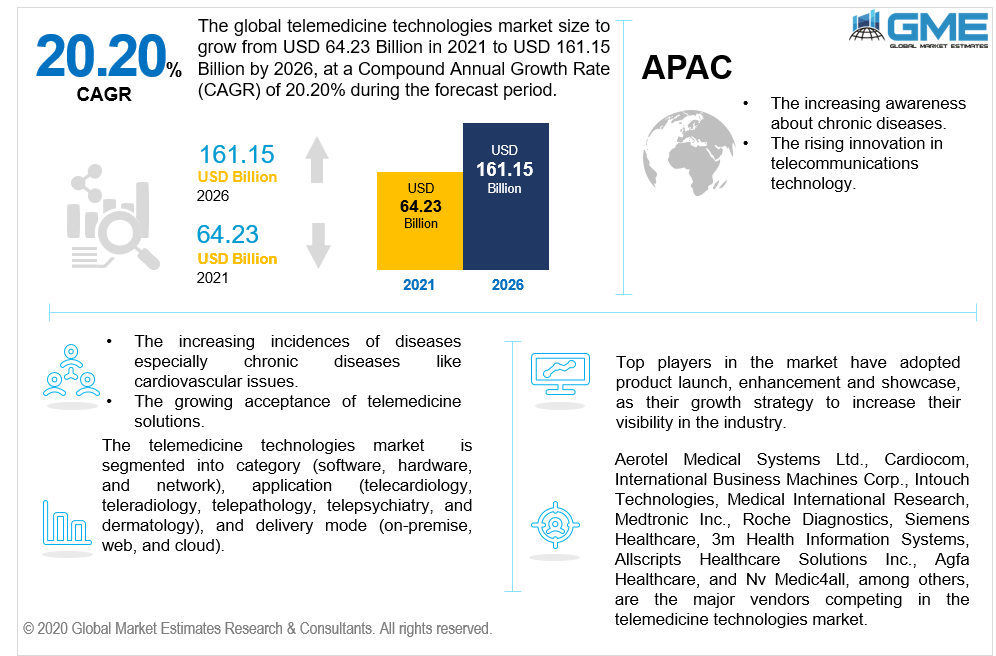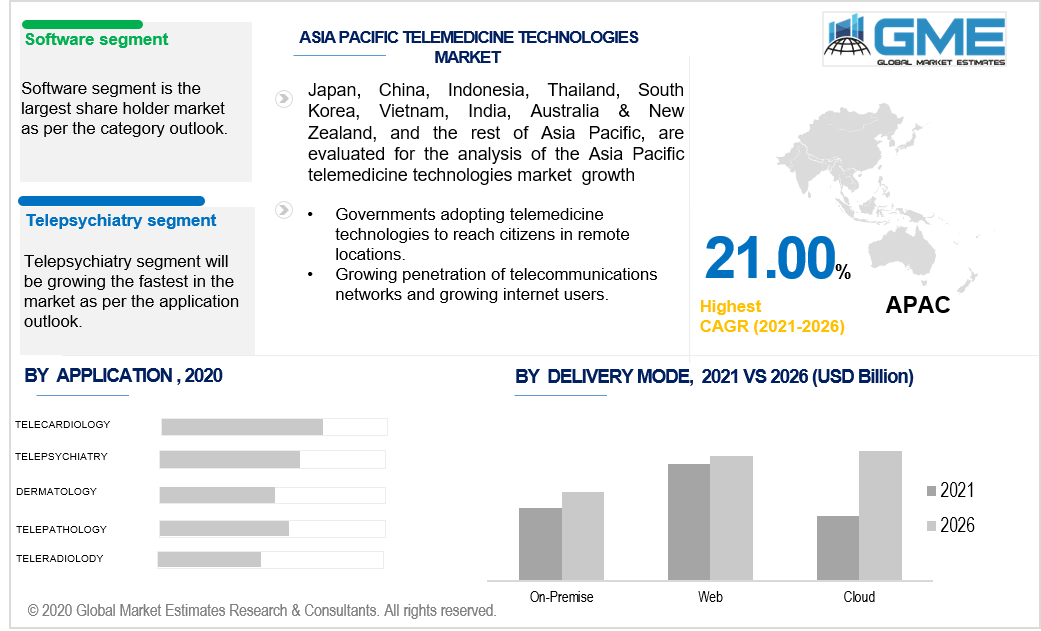
Global Telemedicine Technologies Market Size, Trends, and Analysis - Forecasts To 2026 By Category (Software, Hardware, and Network), By Application (Telecardiology, Teleradiology, Telepathology, Telepsychiatry, and Dermatology), By Delivery Mode (On-Premise, Web, and Cloud) By Region (North America, Asia Pacific, CSA, Europe, and the Middle East and Africa); End-User Landscape, Company Market Share Analysis and Competitor Analysis
Telemedicine technologies utilize communication networks and information technology to provide clinical healthcare to people. With advancements in telecommunication technology, it has become increasingly easier to provide professional medical consultations to people in remote areas. As people in remote locations are unable to find proper healthcare there have been many instances of fatal ailments that could have been avoided had there been timely inferences from medical professionals. With telemedicine technology, medical professionals can diagnose a wide range of diseases and also allow them to convene with other experts. Growing occurrences of healthcare issues and chronic diseases have led to a positive impact on the growth of the telemedicine technologies market. The rising awareness of chronic diseases especially cardiovascular problems has seen people rely more on telemedicine technologies. With telemedicine technology, people can get symptoms checked by professionals at lower costs which can help them find irregularities at earlier stages and get the treatment required before it gets worse. The growing acceptance of telemedicine is boosting the medical market. As telemedicine technologies are reliant on telecommunications infrastructure, the massive infrastructure cost and requirements will prove to be a hindrance to the growth of the market. Privacy concerns among users especially leakage of confidential medical data and patient records have hurt the growth of the market. Government organizations have undertaken many initiatives and policies that have contributed to the growth of the telemedicine market. COVID-19 restrictions have seen people turn to telemedicine due to quarantines or fear of exposure. As telemedicine technology can help spread contagious diseases from infecting healthcare providers as they can assess the patient remotely. Telemedicine technologies also help governments to educate the public on healthcare matters and also allow them to access a much larger part of the population. This allows governments to help citizens that are afraid for their health as quickly as possible while cutting down the risks and cost that would normally take to help them. This has helped improve the acceptance of telemedicine technologies among people. Countries in the E.U region have relaxed some of the restrictions placed on the telemedicine industry. Countries in the EU have implemented telemedicine-based solutions to fight the spread of COVID, solutions like ESSENCE which aim to monitor, stimulate, enrich, and assist the elderly and children to prevent the spread of COVID.

Telemedicine technologies can be categorized as network, hardware, and software. The software segment has held the largest market share. Rising investment in the development of novel telemedicine technologies that can give them a competitive edge over their competitors is responsible for the market dominance by the software category. Growing reliance on telemedicine technologies by governments to monitor COVID patients under lockdown has also helped the growth in the software market segment of telemedicine technologies. Software is easier to implement and use by consumers than network and hardware-based telemedicine technologies. Network and hardware-based telemedicine technologies would require new infrastructure and technical know-how to implement, making them more expensive than their software counterpart. As telemedicine technologies aim to reach as many people as possible, the software segment has higher demand than the other two as healthcare providers would prefer software for its wider reach and easier application.
The telemedicine technologies market can be segmented based on their application as telecardiology, teleradiology, telepathology, telepsychiatry, and dermatology. The telecardiology market segment had a dominant share of the market. The rising incidences of cardiovascular issues among the population have seen this segment dominate over the other applications of telemedicine. The growing occurrences of mental health issues and growing awareness about them among the population have seen the telepsychiatry market grow at the fastest rate.
Based on the delivery mode, the market is segregated and explained into on-premise, web, and cloud-based telemedicine technologies. The web-based segment occupied a major share in the market. The advancements in telecommunication infrastructure and growing usage of the internet among people have seen web-based telemedicine technology dominate. Cloud technology has come a long way in recent years with massive advancements in cloud-based technology and people’s acceptance of cloud-based solutions has seen the cloud-based segment grow at the fastest rate. Cloud-based solutions allow for faster diagnosis and interconnectivity between the caregivers and patient while ensuring that relevant data can be accessed and stored securely.

The North American region held the largest share of the market while the APAC region showed the fastest growth rate. The North American region’s excellent telecommunication infrastructure along with a large number of internet users have had a positive impact on the market in this region. The APAC region’s faster growth rate is mainly due to the growing acceptance of telemedicine by the people. Governments in the APAC region are turning to telemedicine to reach citizens living in remote areas. The APAC region has countries with different geographical features that make it harder for healthcare providers to provide their services to people in remote areas. The poorer infrastructure compared to the North American region will result in more governments implement telemedicine solutions to fight the spread of COVID. With infrastructural developments and a growing internet base, the APAC region will continue to show excellent growth in the telemedicine technology market.
Aerotel Medical Systems Ltd., Cardiocom, International Business Machines Corp., Intouch Technologies, Medical International Research, Medtronic Inc., Roche Diagnostics, Siemens Healthcare, 3m Health Information Systems, Allscripts Healthcare Solutions Inc., Agfa Healthcare, and Nv Medic4all, among others, are the major vendors competing in the telemedicine technologies market.
Mergers and acquisitions are other driving factors in the growth of the telemedicine technologies market. Various telemedicine companies like Cardiocom which was acquired by Medtronic have been either acquired or merged with other larger medical healthcare companies to increase their revenue.
Please note: This is not an exhaustive list of companies profiled in the report.
We value your investment and offer free customization with every report to fulfil your exact research needs.
The Global Telemedicine Technologies Market has been studied from the year 2019 till 2026. However, the CAGR provided in the report is from the year 2021 to 2026. The research methodology involved three stages: Desk research, Primary research, and Analysis & Output from the entire research process.

The desk research involved a robust background study which meant referring to paid and unpaid databases to understand the market dynamics; mapping contracts from press releases; identifying the key players in the market, studying their product portfolio, competition level, annual reports/SEC filings & investor presentations; and learning the demand and supply-side analysis for the Telemedicine Technologies Market.

The primary research activity included telephonic conversations with more than 50 tier 1 industry consultants, distributors, and end-use product manufacturers.

Finally, based on the above thorough research process, an in-depth analysis was carried out considering the following aspects: market attractiveness, current & future market trends, market share analysis, SWOT analysis of the company and customer analytics.

Tailor made solutions just for you
80% of our clients seek made-to-order reports. How do you want us to tailor yours?
OUR CLIENTS